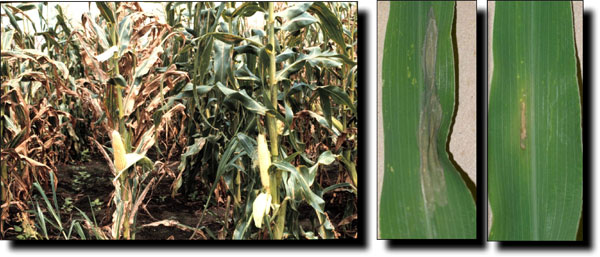| Corn and Sorghum Fungal Disease Laboratory |

|
|
1 - Corn and Sorghum Fungal Disease Laboratory
2 - Page 2 3 - Page 3 4 - Page 4 |

 |
|  |
The primary goal of the research is to obtain information that will expand approaches for controlling fungal diseases of corn and sorghum and lead to new and improved disease management practices. The principal research activities in the lab focus on northern leaf blight of corn, caused by Setosphaeria turcica, and gray leaf spot of corn, caused by Cercospora zeae-maydis and C. zeina. Additional projects concern the biosynthesis and action of phytotoxic metabolites produced by fungal pathogens and their role in pathogenesis. The lab is located within the Crop Production and Pest Control Research Unit of the USDA-Agricultural Research Service, in Lilly Hall on the Purdue University campus in West Lafayette, Indiana. The research is a component of a CRIS project on Molecular and Genetic Mechanisms of Fungal Disease Resistance in Grain Crops.
Current research projects in the laboratory include:
Role of cercosporin in gray leaf spot of corn. Gray leaf spot is caused by two genetically and taxonomically distinct fungi, Cercospora zeae-maydis and C. zeina. Like many species of Cercospora, C. zeae-maydis produces cercosporin, a light-induced, photoactivated perylenequinone that is toxic to a diverse array of organisms. Cercospora zeina elicits identical disease symptoms but does not produce cercosporin in culture, suggesting that cercosporin is not essential for pathogenicity or virulence. To address the role of cercosporin in pathogenesis, we initiated a project to identify, characterize, and disrupt genes associated with cercosporin biosynthesis. Analysis of a cDNA subtraction (SSH) library revealed transcripts that are up-regulated during cercosporin synthesis. We focused on sequences with high homology to genes involved in signal transduction. Northern analyses of gene expression in cercosporin-inducing and cercosporin-suppressing media confirmed the involvement of a MAP kinase kinase kinase (designated CZK3). Targeted gene disruption of CZK3 generated a mutant that is unable to produce cercosporin and does not produce conidia but is unaffected in vegetative growth. Inoculation of corn leaves with mycelia of the czk3 mutant resulted in small chlorotic lesions with minimal colonization by intercellular hyphae following penetration through stomata. The results indicate that CZK3 regulates functions that are important for pathogenesis and suggest that cercosporin is required only after the early stages of infection for extensive colonization and lesion expansion. Current efforts are directed toward understanding the role of cercosporin by analyzing mutants affected in their ability to perceive or transmit light signals and other environmental cues that influence cercosporin synthesis.
Light-regulation of conidiation and pathogenesis in Cercospora zeae-maydis and Setosphaeria turcica. Conidia of the pathogens causing gray leaf spot and northern leaf blight are the primary inoculum, inciting leaf lesions and initiating the disease epidemic, and are the source of repeated infections via wind dispersal to other plants and fields. Sporulation in these two pathogens is inhibited by growth in constant light and regulated by nutritional factors. We are investigating the physical and nutritional factors as well as the biosynthetic activities that are essential for conidial development and pathogenesis in these fungi. Only wavelengths in the blue light range repress conidiation, which contrasts with numerous other fungal species in which blue light induces or substantially enhances conidiation. In a project led by ARS Research Associate, Dr. Burt Bluhm, our primary objective is to characterize the gene(s) encoding blue-light photoreceptors and identify light-regulated genes that influence conidiation and biosynthesis of cercosporin in order to discover potential targets for disease control. Preliminary results have indicated that mutants of C. zeae-maydis disrupted in the CWC-1 gene encoding white collar-1, a putative blue light receptor in fungi, are light blind in conidiation and cercosporin synthesis but nevertheless are unable to cause disease symptoms beyond small chlorotic spots at the site of penetration.
Molecular analysis of resistance of corn to Setosphaeria turcica. The host-pathogen interaction in northern leaf blight is controlled by single dominant genes in the corn host that condition resistance to specific races of the pathogen. Thus, it presents a rare opportunity to study gene-for-gene interactions in corn and critically evaluate the involvement of defense mechanisms established in model plant species. The approach involves microarray analyses of genes expressed during stages of disease development in near-isogenic lines of corn differing in the presence of a specific gene for resistance. In addition, this genetically defined pathosystem can be exploited to determine the mechanism of virulence in the pathogen. Our project evaluates the potential involvement of phytotoxins with genotype specificity or, alternatively, of race-specific avirulence factors, e.g., extracellular peptides, that interact directly or indirectly with the individual resistance gene products to ascertain the phenotypic consequences of the host-pathogen interaction. ARS Postdoctoral Research Associate, Dr. Burt Bluhm, is leading this project.
| [1] 2 3 4 Next >> |



